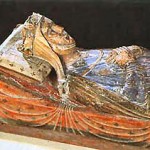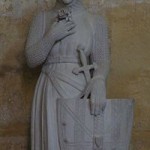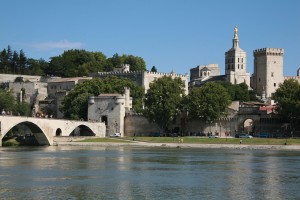Tag: Eleanor of Provence
A Game of “10 Questions” with Kayla at the Pittsburgh Historical Fiction Examiner
I am happy to be back at the Pittsburgh Historical Fiction Examiner today as part of Kayla’s “10 Question” series. So, if you’ve ever had a pressing desire to know which five people from history I’d like to host at a dinner party, or what I drink when writing (no – not cocktails), now is your chance to find out.
Or, if you are interested in learning more about the inspiration for my debut novel, The Sister Queens, and the amazing women at my story’s heart (Marguerite and Eleanor of Provence), I did this earlier interview at The Examiner on those topics.
On This Day in Her Story #8: A Reunion of The Sister Queens

In October of 1254 Henry III and Eleanor of Provence receive permission from Louis IX of France to travel through his kingdom while making their way back to England from Gascony.
King Henry is eager to visit the grave of his mother, Isabella of Angoulême, at Fontevrault Abbey. Eleanor is excited by the prospect of seeing her sister Marguerite (Queen of France) after nearly two decades of separation. The stage is set for a family reunion between Provencal sisters and a meeting of their royal husbands during the Christmas season.
On This Day in Her Story #7: A Namesake for Marguerite of Provence
On This Day In Her Story #4: The Death of Raymond Berenger
August 19th 1245 – Marguerite and Eleanor’s father, Raymond Berenger, Count of Provence dies and their sister Beatrice inherits Provence. Because Raymond dies in the midst of a massive power struggle between Pope Innocent IV and Holy Roman Emperor Frederick II, the question of succession inProvence takes on an international dimension and competition to lay claim to Beatrice’s hand is fierce.
On This Day In Her Story #3
On This Day In Her Story #2
Location, Location, Location — Thoughts on the Use of Genuine Locations in Historical Fiction
My dear friend historical romance author Miranda Neville wrote an interesting piece at The Ballroom blog. The gist of Miranda’s post is that writers have an incredible collection of historical real-estate to browse when creating settings for their historical novels (whether straight or romance), and at each location we can cherry-pick the very best parts and amalgamate them into something new. For example, Miranda incorporated The Marble Saloon at Stowe into the fictional Mandeville House—setting for her just released The Amorous Education of Celia Seaton as well as two of her other romances.
Miranda’s post got me thinking about several additional points relevant to historical settings—specifically, pertaining to the use of real locations rather than locations created in the mind of the writer.
Timing is everything! Great cities, great cathedrals, and houses (both great and not so great) change over time. When an actual historical location is used in a novel we need to remember that—however iconic—that setting was not stagnant. Whether you are describing the skyline of Avignon or Westminster Abbey you’d better know what period you are writing about before you begin waxing wane with descriptions. And as a reader, you shouldn’t be too quick to expect certain locations to look certain ways (e.g., as they did when you visited, or in Aunt Irma’s postcards).
For example, Westminster Abbey is a true historic landmark. Millions have visited it, and many more have seen it in pictures or movies. What they’ve seen—and the images that rise to their minds when the Abbey is mentioned—is not the Abbey that existed when Eleanor of Provence was crowned Queen of England there in 1236. In fact, Eleanor’s husband, Henry III, was responsible for a masterful renovation of the Abbey (leaving it dramatically changed for generations to admire), a reconstruction that took years. As a result, the Abbey would have looked very different at various points in my novel, The Sister Queens.
Similarly, for much of its history (and today) the outline of the city of Avignon has been distinguished by the Papal Palace (gorgeous). But at the time of my novel, when Avignon was part of the Count of Provence’s territories, the great medieval palace seen in paintings and photographs didn’t’ exist. Describe Avignon including the palace and get it wrong. Read expecting to see the palace and it won’t be there. This is why it’s a darn good thing that . . . .
Historical novels are NOT guidebooks. While it IS important not to be anachronistic when portraying settings—making certain not to include features in an exterior or interior that didn’t exist in a particular time period—it is okay not to flesh out every corner of a room or every façade of a palace. I certainly believe that an author needs to know the world of her novel in depth in order to move her characters through it convincingly, but, unless you are describing the maneuvers of troops in a battle, sharing too much detail is unnecessary. A little era-setting detail often goes a long way. Readers like to use their imaginations, or at least this one does. When an author throws in too much description just because she/he has the research to support it, or when I feel he/she is showing me miniscule detail gratuitously (the details themselves are interesting or intriguing but in no way relate to the plot), I start to skim. Skimming is bad.
Of course there ARE occasions when an infusion of detail can enrich the reader’s experience. This is particularly true when we want readers to share the sensory experiences of a character—a young woman overwhelmed by the view from a chateau, or nearly dizzied by the incense-saturated air and soaring voices singing the Laudes Regiae in a magnificent abbey. Nothing can draw a reader into the emotion of a moment more effectively than the purposeful inclusion of carefully selected details of the historical setting. But note that I said, “purposeful inclusion” and “carefully selected.” Filtering is a must. Try to load the same level of detail into every scene in your historical novel and you ruin the effect.
Writers can also use setting itself as catalyst to move a scene forward. Of course on the large scale this fact is obvious—pick any scene in a historical novel and move the setting as a form of exercise (from the gardens of a grand Château to its great hall). The meaning of and physical movements in the scene are likely to change, even if you attempt to keep the dialogue the same. But, setting as catalyst can also occur in small subtle ways in fiction as it does in real life. Have you ever noticed something—on your desk, outside your window—that, serendipitously, makes your mind leap to a new place and to a particular idea or to action? That can happen to characters too. A mother picks up a bird’s nest and thinks of her children. The pattern in a window reminds a character of a gown and thus of a particular partner from the ball the evening before. I find as a writer I often want, even need, to place a certain scene in a certain setting in order to take advantage of elements of the architecture or décor that I know by my research would have existed in that place at that time.
What about you? As a writer how do you handle the REAL real-estate that makes an appearance in your work? As a reader how much detail is enough to make you feel immersed in the past? Where does the amount of detail cross a line, leaving you bogged down? Do you have strong feelings about the balance between real settings/descriptions based on research and locations/rooms created in the mind of the author?
Invention is the Midwife of Good Historical Fiction
Necessity may be the mother of invention, but invention is the midwife of good historical fiction.
Invention and creativity are good things. But in historical fiction we (writers) sometimes lose sight of that, and get bogged down in the minutiae of our period and the thousand little details in our characters’ lives. I was recently reminded, with force, that readers come to authors of historical fiction for something more than a collection of facts.
I had the opportunity to hear Susan Vreeland, a master of the genre, speak at a recent Historical Novel Society Conference. I thought Susan was going to do a presentation on her latest book. But, when we were gathered before her in our neat little rows, she decided to tackle a larger issue – the role of invention in historical fiction.
“Don’t be tyrannized by fact.” That’s how Susan opened her presentation. And she is right of course. Historical fiction is not academic history. Does accuracy matter in historical novels? You bet your farthingale it does but, “fictional art can show truth that goes deeper than a collection of fact; it can show us what it felt like to be a particular person at a particular time” (again, Susan V). Besides, “as soon as something happens people start lying about it” (Cecelia Holland) so “truth” in history can legitimately be debated.
Susan pointed out that selection (and correspondingly, elimination) of facts is part of the process of writing compelling historical fiction. Good authors know instinctively – whether they write historical fiction or another genre – that telling just the right bits is what gives a great story its focus. Authors of historical novels must choose only those events from history that relate to the specific premise/themes of their particular novel. It doesn’t matter how interesting an event is (or how pivotal it is in the life of a historical character), if that event doesn’t forward the plot of the book an author is writing, then it needs to be left out. There were dozens of interesting events in the lives of my main characters, Marguerite and Eleanor of Provence, during the twenty-year period covered by The Sister Queens that did not make it into my novel because they were not germane to the “sisters” theme of my book. Continue reading Invention is the Midwife of Good Historical Fiction
On This Day In Her Story
 Today I am inaugurating a new series here at blog-central called “This Day In Her Story.” I will use it to feature historical tidbits that are germane to the stories of my sisters Marguerite and Eleanor of Provence. Enjoy!
Today I am inaugurating a new series here at blog-central called “This Day In Her Story.” I will use it to feature historical tidbits that are germane to the stories of my sisters Marguerite and Eleanor of Provence. Enjoy!
On This Day In Herstory #1
July 17th 1242 – The marriage contract between Henry III’s brother Richard, Earl of Cornwall, and Eleanor’s sister Sanchia is concluded. Talk about keeping it all in the family 🙂
Why Our Sisters are NOT Ourselves
Some things stick with you.
Last fall I heard this piece on NPR about breakthroughs in sibling research. It has been with me ever since—rumbling around in my brain.
This is the quote that got me:
Physically, siblings tended to differ somewhat, but they were a lot more similar on average when compared to children picked at random from the population. That’s also true of cognitive abilities.
“The surprise,” . . . “is when you turn to personality.”
Turns out that on tests that measure personality — stuff like how extroverted you are, how conscientious — siblings are practically like strangers.
“Practically like strangers” yet raised together. I’ve certainly had moments when I’ve thought how can my sister and I have had such a different experience of the same childhood or how could we have played the same games (together), walked to the same school (together) and heard the same family stories and yet turned out so very differently? If you have a sibling chances are you’ve had such thoughts as well. At the heart of my questions lay the idea that nurture shapes people, and since my sister and I were raised in the same environment that should have made us similar.
Turns out that’s just dead wrong when it comes to siblings. Being raised in the same environment helps to make us different. The three theories posited in the radio report sounded eerily familiar—though, as an author not a scientific researcher, I’d given them different names while writing The Sister Queens.



